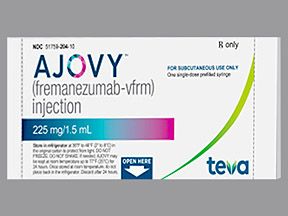Ajovy (fremanezumab-vfrm) is a prescription, brand-name medication. The Food and Drug Administration (FDA) has approved it to help prevent migraine in adults.
Ajovy comes in two forms: a prefilled autoinjector and prefilled syringe. The drug is given as a subcutaneous injection.
Ajovy belongs to a group of drugs called calcitonin gene-related peptide (CGRP) receptor antagonists.
Ajovy is a
For information about the dosage of Ajovy, including its strength and how to take the drug, keep reading. For a comprehensive look at Ajovy, see this article.
This article describes typical dosages for Ajovy provided by the drug’s manufacturer. When taking Ajovy, always follow the dosage prescribed by your doctor.
Below is information about the typical dosages for Ajovy. But your doctor will recommend the best dosing schedule of Ajovy for you. Be sure to always take the dosage of Ajovy your doctor prescribes for you.
Ajovy forms
Ajovy comes in two forms: a prefilled autoinjector and a prefilled syringe. The drug is given as a subcutaneous injection.
Which form of Ajovy you use depends on the form you and your doctor agree is best for you. Regardless of whether you take Ajovy monthly or quarterly, either form may be used.
Factors that can influence which form of Ajovy you use can include:
- your personal preference between the autoinjector and prefilled syringes
- your insurance coverage, and whether they prefer one form of Ajovy over the other
If you have additional questions about different dosage forms of Ajovy, talk with your doctor.
Ajovy strength
Ajovy comes in one strength: 225 milligrams (mg) per 1.5 milliliters (ml) of solution.
Typical Ajovy dosing
The following information describes dosages that are commonly used or recommended. However, be sure to take the dosage your doctor prescribes for you. Your doctor will determine the best dosage to fit your needs.
There are two different dosing options for Ajovy. You can take your dose of Ajovy either as a monthly dosage or a quarterly dosage (once every 3 months). The monthly dosing schedule is a 225-mg injection of Ajovy once per month. The quarterly dosing schedule is three 225-mg injections given one after another for a total of 675 mg. This dose is taken once every 3 months.
In clinical trials of people taking Ajovy, a loading dose was prescribed in some cases. A loading dose is a high dose of medication that’s given at the beginning of your treatment. This allows the drug to start working quickly.
In some of the trials, people received a starting dose of 675 mg, and then received a 225-mg dose once per month after that. But at this time, a loading dose of Ajovy is not recommended. So, the maximum dosage of Ajovy is 225 mg per month or 675 mg per quarter, depending on what your doctor prescribes.
Long-term use
Ajovy is meant to be used as a long-term treatment. If you and your doctor determine that Ajovy is safe and effective for you, you’ll likely take it long term.
If you miss a dose of Ajovy, take it as soon as you remember. Then, take your next scheduled dose as usual.
If you miss a dose of Ajovy and have questions about when to take your next dose, talk with your doctor or pharmacist.
To help make sure that you don’t miss a dose, try using a medication reminder. This can include setting an alarm or using a timer. You could also download a reminder app on your phone.
The Ajovy dosage your doctor prescribes will depend on several factors. These may include your personal schedule and how often you’re able to inject your medication. Talk with your doctor about the best dosage of Ajovy for you.
Ajovy comes in two forms: a prefilled autoinjector and prefilled syringe. The drug is given as a subcutaneous injection either once monthly or once every 3 months. Your doctor can give you your dose of Ajovy or they can show you or your caregiver how to inject the medication. It’s important that you do not inject your dose of Ajovy without training from your doctor or pharmacist.
Ajovy can be injected into one of the following areas:
- your abdomen, at least 2 inches away from your belly button
- your thighs
- your upper arms
You should avoid injecting Ajovy into areas that are tender, bruised, or red.
If you inject Ajovy every 3 months, you’ll need to inject three doses of 225 mg, one after another. In this case, you can inject the medication into the same area of your body. But you should not inject it into the exact same location. For example, you can inject all three doses into your thigh, but be sure to pick different areas of your thigh.
For more information on the correct way to inject Ajovy, see the manufacturer’s webpage. It includes videos and step-by-step instructions for the prefilled autoinjector or prefilled syringe.
It’s important that you don’t use more Ajovy than your doctor prescribes. For some medications, taking more than the recommended amount may lead to side effects or overdose.
If you take more than the recommended amount of Ajovy
Call your doctor right away if you believe you’ve taken too much of Ajovy. Another option is to call the American Association of Poison Control Centers at 800-222-1222 or use its online tool. If you have severe symptoms, immediately call 911 or your local emergency number, or go to the nearest emergency room.
The dosages in this article are typical dosages provided by the drug manufacturer. If your doctor recommends Ajovy for you, they’ll prescribe the dosage that’s right for you. Always follow the dosage that your doctor prescribes for you.
As with any drug, never change your dosage of Ajovy without your doctor’s recommendation. If you have questions about the dosage of Ajovy that’s right for you, talk with your doctor.
Besides learning about dosage, you may want other information about Ajovy. These additional articles might be helpful to you:
- More about Ajovy. For information about other aspects of Ajovy, refer to this article.
- Side effects. To learn about side effects of Ajovy, see this article. You can also look at the drug’s prescribing information.
- Details on migraine. For details on migraine, see our headache and migraine hub and list of related articles.
Disclaimer: Medical News Today has made every effort to make certain that all information is factually correct, comprehensive, and up to date. However, this article should not be used as a substitute for the knowledge and expertise of a licensed healthcare professional. You should always consult your doctor or another healthcare professional before taking any medication. The drug information contained herein is subject to change and is not intended to cover all possible uses, directions, precautions, warnings, drug interactions, allergic reactions, or adverse effects. The absence of warnings or other information for a given drug does not indicate that the drug or drug combination is safe, effective, or appropriate for all patients or all specific uses.


